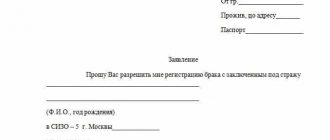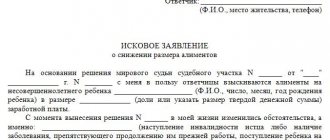In the process of considering civil cases, the parties are endowed with initiative, which means the right to file petitions in court. A petition, or statement, is a written request to carry out certain procedural actions that are important for the proper resolution of civil claims, labor claims, family claims and all others. The persons involved in the case may petition the court orally, but it is better to prepare such documents in writing and attach them to the case materials.
What is a motion to court?
At its core, a motion is a statement by a party to the proceedings, simultaneously containing a request or demand to the judge. The right to appeal to the court if circumstances change or additions are discovered is provided for in the relevant regulations:
- in civil proceedings - Art. 166 Civil Procedure Code;
- when analyzing arbitration disputes - Art. 159 agro-industrial complex;
- when considering administrative offenses - Art. 154 CAS;
- in administrative proceedings – Art. 24.4 of the Code of Administrative Offenses (can be submitted not only to a judge, but also to an official or to the authorities where the issue is being considered).
In each of the listed cases, an appeal to the court can be made in any form (but taking into account the rules for drawing up procedural documents). And only in criminal proceedings are more stringent requirements imposed on the parties’ requests:
- general rules for filing and consideration deadlines are described in Chapter 15 of the Code of Criminal Procedure;
- to initiate an inquiry in a shortened form - Art. 226.4 Code of Criminal Procedure;
- on the exclusion of evidence during preliminary consideration – Art. 235 Code of Criminal Procedure;
- when preparing a court hearing - Art. 271 Code of Criminal Procedure;
- with the consent of the defendant or the conclusion of a pre-trial agreement - Articles 315 and 317.1 of the Code of Criminal Procedure;
- to resolve the issue of expunging a criminal record after serving a sentence - Art. 400 Code of Criminal Procedure.
If in civil cases a petition to the court is drawn up in any form, then in criminal cases the requirements for the document are stricter
Timing Statements
One group of deadlines is established by procedural legislation, the second - by material legislation, the limitation periods.
Both are restored or extended; the prohibition on extension or restoration is provided exclusively by law.
All applications in court are accepted subject to the stated deadlines. If it is missed, the court returns the application, indicating the need for a request for reinstatement. The applicant is required to attach evidence that the omission was valid or evidence that the deadline was not missed at all. For example, the time to file a complaint for some decisions begins to run from the moment the interested party receives information or documents.
The application is attached to the claim or other document or combined with it.
Who can file a petition?
With regard to the filing of petitions during judicial or administrative proceedings in a case, the law ensures equality of rights for all parties involved. The request may come from:
- the plaintiff (his representative);
- the defendant (his representative);
- if the case is criminal - from the suspect, accused, victim (or their legal representatives), as well as from a private prosecutor, expert or organization whose interests were affected during the proceedings in the case under consideration.
It must be taken into account that only their official representatives can submit applications on behalf of one of the parties or participants. The powers of the latter are confirmed by documents:
- a representative of an individual is required to present a notarized power of attorney, allowing him to act on behalf of the client in court and perform procedural actions;
- A full-time employee or a specialist invited under a contract can act on behalf of the organization; his authority is confirmed by a power of attorney on behalf of the first manager (on company letterhead, certified by a “wet” round seal).
The document can be submitted by one of the parties to the process or its legal representative
When and why are applications submitted?
The reasons for going to court in civil proceedings are not structured at the legislative level. The range of topics and reasons is vaguely limited: the essence of the document must clearly relate to the circumstances of the case, supplement it in fact, or make significant adjustments during the proceedings. In addition, applications containing a repeated request or question on which a decision has already been made by the same panel of judges will not be accepted for consideration.
Most often, parties request (in non-criminal proceedings):
- on restoring the statute of limitations and scheduling the consideration of the case on newly established dates;
- on postponing a meeting or consideration of a dispute in the absence of the plaintiff (if this is dictated by valid reasons or circumstances);
- on the addition of documents and evidence, calling witnesses or attracting experts;
- about changing the requirements, the amount of compensation (if the amount of damage was clarified during the consideration), about changing the defendant;
- on issuing materials for review or requesting them from a third party;
- on taking interim measures;
- on deferment of payment of government fees and duties (until a final decision is made).
A written appeal must be submitted either before the consideration of the issue begins, or at the court hearing (immediately at the time of the proceedings). If we are talking about rescheduling, then it is better to submit the petition before the day of the scheduled meeting. You can also submit the document through a representative, immediately before the start, if an event occurred that did not allow you to notify the court in advance (hospitalization, force majeure or accident).
The petition can be submitted either in advance or during the court hearing - it all depends on the essence of the appeal
How and when to write?
As we mentioned above, the petition must be submitted exclusively during the consideration of the case, unless we are talking about restoring the missed period for the discount on the fine.
The procedure for considering a case by a traffic police inspector on the road according to the law is as follows:
- In essence, an administrative case is initiated by a protocol,
- and the consideration ends with the issuance of a decision.
And the subtlety is that the Code of Administrative Offenses gives officials the right to make a decision without drawing up a protocol, and if the driver disputes the violation, draw up a protocol after issuing a fine. Thus, a conflict arises when the petition must be submitted before the decision is made and the difficulty is to have time to do this. And this is a big flaw in the Administrative Code.
For example, a driver is stopped by a traffic police officer with some violation, demands documents and checks them. Then he begins to write the resolution. And before he puts his signature on it, you need to have time to write a petition (about transferring the case materials to the place of residence, about attaching the registrar’s record, imposing a minimum sentence, and so on).
Something else useful for you:
- What are the penalties for repeated violations and how long does the repetition last?
- How to appeal a speed camera ticket? Complaint form, procedure, deadlines
- How to appeal a fine for not allowing a pedestrian to pass? Form, sample and instructions
What if I don't have a piece of paper and a pen?
Neither the inspector nor anyone else has an obligation to provide them to you.
That is why we recommend that you prepare your petition in advance so that the general data is already written on a piece of paper, and all you have to do is enter the name of the employee or judge and the very essence of the petition - what you are asking for.
Is it possible to make a request orally?
Oral petitions can only be made during the court hearing itself, when the secretary keeps minutes and records all the facts and statements made by the parties. In this case, it is enough to follow a simple algorithm:
- Declare your desire to file a motion during the consideration of the case.
- State the essence of the request and argue it before the judge.
- Wait for the court's decision on the stated issue (if the facts and arguments presented do not require additional verification, a decision on it is made immediately).
In civil or administrative proceedings, the parties often do not resort to the help of professional lawyers, so the text of their appeals may not contain a reference to articles of codes and other legal acts. The absence of the latter cannot serve as a reason for rejection or refusal to consider a document if the request complies with the spirit of the law, falls within the competence of this court and is relevant to the current case.
Important! The refusal or positive decision of the judge must necessarily contain a reference to a specific article of the regulatory legal act.
A request to the court can be expressed orally if this is done during a hearing
What are the review deadlines?
There are none, from the word “at all”. The deadline for consideration of the application in 2022 is not regulated by any law or other legal act.
But there are deadlines for consideration of the case:
- if it is considered by a traffic police officer, then the period is 2 months, after which the official is obliged to issue a decision or determination of refusal,
- if the case is considered by a judge, then this is already 3 months.
During this entire period, petitions from the parties to the case are subject to consideration. But the case itself cannot be considered without studying such “moves”.
Rules for writing and structure of the petition
The form and sample for writing a petition are not defined by law. The author of the document must adhere to the general principles of drawing up procedural documents. This means that the paper must contain several required blocks:
- introductory – “header” containing the name of the authority, the composition of the participants and their procedural role, and contact information;
- a title that reflects a brief essence;
- content and argumentation;
- requirements put forward by the author of the appeal;
- list of applications;
- date and signature (mark of acceptance of the document if it was submitted through the office).
Instructions for writing a petition
Basic principles for drafting a document:
- clear addressing (where it is submitted, from whom and for what purpose);
- definition of the form of appeal (the title must contain the word “petition”);
- a dry presentation of circumstances and an unambiguous formulation of requirements, supported by arguments with reference to legal norms;
- petitions can only be made on issues of the current dispute;
- the appeal cannot in its form be a complaint against the actions or inaction of judges, officials or the injustice of their decisions.
The petition must relate only to the current case and include only one request
Drawing up a document header and specifying details
The introductory part of the appeal (“header”) is similar in content to the statement of claim. It must indicate:
- name of the court (can be supplemented with postal address and details of the appointed judge);
- definition of the applicant (who exactly is applying to the court: plaintiff, defendant or one of their representatives);
- details of the plaintiff (full name, address, including email, current telephone number for operational communication);
- information about the defendant (full name, address and other known information about him).
Important! If a decision to open a case and consider the issue has already been made, then in the header of the petition it is necessary to indicate the full name of the appointed judge and the case number. This will speed up the work of clerks, and the paper will immediately reach the recipient’s desk.
Writing the main part
If you decide not to resort to the help of lawyers, sample petitions to court will help you draw up the document correctly.
Despite the need to provide arguments, there is no point in “inflating” the text of the petition. The main part must have two mandatory sections:
- a statement of circumstances (if we are talking about rescheduling dates, reinstating missed deadlines or forced absence, then you need to prove that the reasons are valid);
- unambiguously formulated requirements (what the applicant specifically asks for).
Following this rule will increase the chance of the paper being accepted for consideration and the request contained in it being satisfied.
Important! One petition must be dedicated to one event. You should not combine a request to postpone the hearing and call a witness in one appeal.
Attached documents
It is important for the applicant not only to understand how to legally correctly write a petition to the court, but also how to prove the validity of his position (especially when the existing sample does not contain at least an approximate list). Depending on the nature of the appeal, the following may be attached to the document:
- when rescheduling dates or reinstating deadlines - copies of documents indicating the impossibility of attending a meeting on time or filing a claim in a timely manner (for example, sick leave or a copy of an extract from the medical history, a business trip order, a “stub” of a sanatorium voucher for undergoing the necessary treatment or rehabilitation plus a doctor’s opinion on the urgent need for these procedures);
- on adding evidence or changing claims - copies and originals of newly presented documents, payment slips, certificates of work performed, conclusions of appraisers, service centers or repair organizations;
- on deferment of payment of state duty - copies of certificates proving membership in a socially unprotected category (pensioners, disabled people, parents or guardians with many children, etc.) or a certificate of the applicant’s income indicating that the amount of the fee is too high for him.
The above list is far from exhaustive. A person petitioning the court has the right to attach to his petition any document or a copy thereof that seems appropriate and justified to him.
Important! There is no state fee charged for filing a petition (as opposed to a statement of claim). The number of written or oral appeals within one judicial proceeding is not limited by law.
General application form
Procedural standards do not focus on how to correctly fill out a petition to the court (the most that can be found is a sample posted on stands with information for visitors). A guideline for those involved in non-criminal proceedings can be Articles 131 and 132 of the Code of Civil Procedure (on the composition of statements of claim and appendices thereto).
How to draw up a document correctly
General rules on how to draw up a petition to the court are not presented in the current legislation, the codes do not provide for any mandatory requirements for the document, and the unified form has not been approved. But for certain types the structure and required details are indicated, as for example in Art. 411 Code of Civil Procedure of the Russian Federation. The article says that the appeal must indicate the names and details of the parties, state the request, and attach evidence confirming the grounds for filing the request. It is recommended to focus on this structure when compiling.
Recommendations on how to correctly fill out an application and how to form the structure of an appeal:
- Compose the introductory part at the top in the right corner. It includes a header indicating the name of the court, full name. and contact details of the plaintiff and defendant (last name, first name, patronymic and address - for individuals, name of institution or organization and address - for legal entities), case number and surname of the judge for quick identification.
- Separate the main part and place it in the center. Here it is necessary to state the essence of your request, the arguments that will contribute to the satisfaction of the request. Here it is written what procedural actions you expect and why they are necessary. It is recommended to support your requirement with references to the relevant provisions of the current legislation. Regulatory justification is not necessary, but is desirable; it will simplify the procedure for considering the application.
- Highlight the operative part. In this paragraph it is necessary to indicate specific requirements, “I ask you to postpone the consideration of the case” or “I ask you to involve me as a third party,” etc.
- Sign and date the document.
- Provide a list of materials that you attach to substantiate your requirements.
When drawing up an appeal, do not forget about certain rules for drawing up procedural documents. The law does not set out the rules for writing a petition; the main thing is to follow the structure and state the request clearly and competently (references to legal norms are not mandatory, but desirable), and provide reasons for satisfying the request. Design by hand is allowed, not on a computer. It is recommended not to use abbreviations, slang, corrections (it is better to rewrite), and write legibly by hand.
To write, it is not necessary to seek professional help; in most cases, this procedure is not difficult. But we must remember that the court does not provide advice; on the contrary, proving one’s position is an integral responsibility of the parties. If writing an application is difficult, it is recommended that you contact a lawyer. Court employees are also not required to advise citizens. Typically, the courthouse contains current examples and samples of petitions (blank), and forms of other procedural documents. For those who easily navigate the Internet, it will not be difficult to find how to write an appeal to the court - samples are posted on the official websites of judicial departments. For those who prefer to communicate with consultants directly, here is some advice: near the location of the judicial authorities there are often law firms whose employees are professional representatives in court hearings.
There are no general requirements on how to correctly file a petition in court in a civil case, but for individual petitions only a written form is provided - for an examination, for the collection of expenses for a representative. If the obligation to comply with a written form is not expressly stated, an oral statement is allowed and recorded in the minutes of the court session. It is recommended to use a written form; outside a court hearing, a written appeal is transmitted through the office, by mail, or through the court’s website (with an enhanced qualified electronic signature). With any method of filing, the appeal is issued according to the number of persons participating in the case, so that they can familiarize themselves with the materials of the case in a timely manner.
Reasons for rejecting petitions by the court
You need to understand that a request can be rejected at different stages of its presentation:
- at the time of filing - if it was not filed at the place where the claim was considered, if the required details are not indicated, if the applicant’s signature is missing or his representative cannot present the appropriate power of attorney;
- after consideration by the judge - if the issue set out in it does not fall within the competence of this authority, a decision on this dispute has already been made or the requirement contained in the appeal does not find regulatory confirmation and justification.
How to choose an application format
If a citizen is puzzled about how to write a petition, a sample can be downloaded from the official website of the desired department. To determine the format, you need to pay attention to a number of points:
- Study the sample petition and see if it contains references to by-laws, as well as resolutions.
- If such links exist, it is important to know whether they are relevant or not.
- Study the specific legislative norms that are in the example. It may be that they changed during the search.
In any situation, you should initially figure out whether a particular sample or template is considered relevant at the time of the search. You need to know that when searching for an example of a petition, it is wiser to use several sources. This applies to any subject of the “request” and the addressee.
Methods for filing an application
The application must be submitted in person, electronically or by mail
The law does not limit the parties in how they can deliver a petition to the court; for example, the applicant is free to:
- submit it through the office - personally or through a representative (it is advisable to submit the paper in two copies in order to receive a note about the fact and date of submission);
- send via telecommunication channels - using a digital signature (digital signature must be issued in the name of the applicant: citizen, individual entrepreneur or director of the organization);
- use mail or courier delivery services - here it is important to take into account the timing of the letter in transit (if the item is “late”, the judge may refuse on a formal basis);
- orally - exclusively during the hearing (if it is stated in words in the court office, then the clerks will not transfer it to the judge).
Samples of petitions to court
Sample petitions vary somewhat depending on what requests they contain. Main differences:
- the need to indicate the case number - if the proceedings have already been opened, then it is necessary to indicate it;
- clarification of the name - a brief explanation of its essence must be added to the word “petition” (therefore, you should not combine several different demands in one application);
- submission deadlines – certain types of applications only need to be submitted in advance.
A generalized sample for addressing a judge looks something like this:
If it is necessary to adjourn a meeting, the following basis can be used:
And if the plaintiff wants to recover legal costs and the paid fee in full, then the following example will be useful:
Order a free legal consultation
Application for promotion
In this situation, how to write a petition correctly (a sample petition is given below)? Various situations may arise at work when an employee needs to be rewarded or disciplined. You can launch these procedures by correctly writing the appropriate “request” to higher authorities. Each organization has its own rules of business etiquette - they will influence who draws up this document.
In most situations, this responsibility falls on the shoulders of the HR department. But it happens that the responsibility is shifted to employees who will receive bonuses or deductions.
In this situation, no one can guarantee that the personnel employee will provide a correctly drawn up example of a petition that will correspond to the current situation.
Therefore, it is necessary to look for a sample application in advance. We’ll tell you in this article how to correctly formulate a request that will help you avoid problems and endless document editing. To do this, you just need to consult with a competent lawyer and find a sample document.
If the petition concerns bonuses for an employee, it is usually addressed to the main manager of the organization. You can make a written request in free form, but there are a number of nuances that should always be taken into account.
At the conclusion of the petition, it is necessary to briefly outline all of the above. At the end of the document it is indicated - “reward”, “transfer to a higher position”, “recover”.





